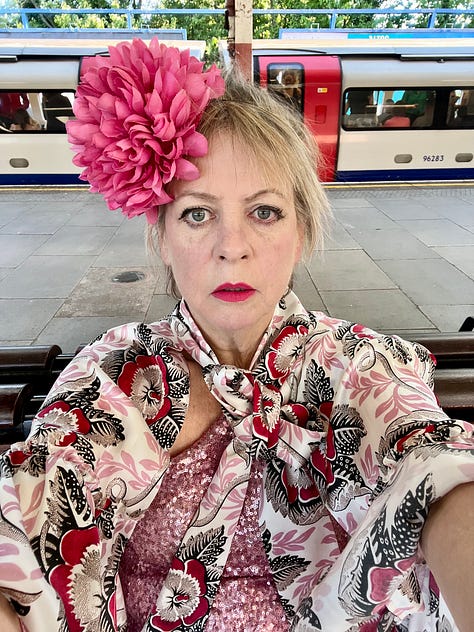
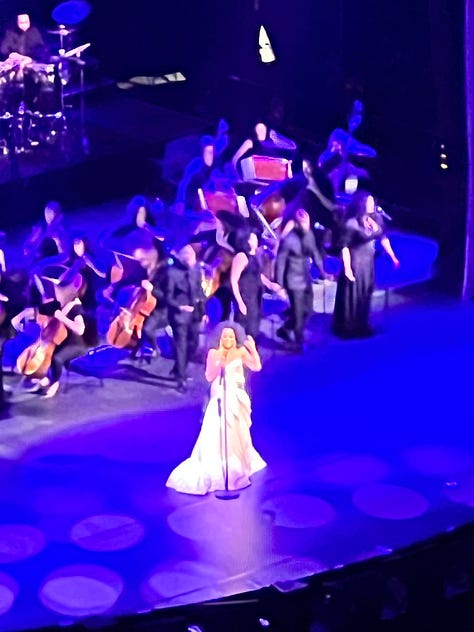

Ross was the first modern day famous Diana, the one before the princess. The first one on everybody’s lips - she had a seemingly unending sequence of number one hits – back when Top of the Pops was essential national viewing.
I grew up with Diana Ross. I remember her long sequin gowns with a split up the leg, the ultimate glamour from a child’s viewpoint. In the playground I’d imitate Shirley Bassey ‘The minute he walked through the joint’ and Diana ‘Aint no mountain high enough’.
I got a £15 ticket to see her at the O2 centre. We were up in the Gods - up the death stair. I was, by way of homage, wearing a full-length one-shouldered pink sequin gown (and finally wore my Vampire’s Wife cape). Trying to go to the toilets in the interval was a dizzying experience. The stairs were practically vertical, with no hand rails. For a second I thought I’d tumble 100 feet.
Her voice may be a little weaker than it was, she’s now 80, but the backing band and the sound were full and melodious. So different from Rod Stewart at Glastonbury a few days before. Rod and The faces was the first solo gig I saw as an adolescent. Now, on the sunday afternoon slot during a heatwave he looked as if he were going to collapse. His voice has basically gone, the characteristic croak no more. The show was more than a little Vegas. I did like the blond backing singer clones though - all looking like some unholy mashup of his wives and girlfriends. So camp.
I got weepy during Diana Ross. I remembered my first best friend Donna, who used to perform with me in the playground. She died falling out of a toilet window at the age of 20. I was at junior school with Donna. She was a source of fascination because her mum was a single mum, very rare in those days, and had seven kids from three different men. Unheard of.
By the age of 14 Donna worked full time, cutting patterns and sewing on the machine, in the fake fur coat factory down the road and I’d join her after school, sewing on hooks and eyes. She earnt a proper wage by the time she was 16. She had a slim body, green eyes, thick dark hair and a wide smile. All the boys fancied her. She was fun and kind. I wonder if, when we die, we will see those we lost?
The Greensleeves Project
At the beginning of this century I took part in a Tudor recreation at a historic mansion in Suffolk, at Kentwell. The only qualification was making (or buying) your Tudor costume. The recreations lasted three weeks. We did a day course on speaking Tudor (thee, thou, and trying to remember not to say ‘ok’ – an expression only invented last century). Visitors would come to the house and observe us at our stations - I worked at the dairy, the blacksmiths, and the cart makers. Sometimes the visitors would try to trick us into saying modern things. We’d feign ignorance as to what an aeroplane was. Meanly they’d do it to the kids too ‘do you like Barbies?’.
I attended an event at The Society of Antiquitaries, next to the Royal Academy. I mainly went to hear Ivan Day talk about Tudor cookery but I stayed the whole day. The project analysed and recreated the costume of the lady in the song ‘Greensleeves’. Reputedly Henry 8th wrote it for Anne Boleyn but it seems that the song, a viral hit, a cultural sign post like Happy Birthday, was written after his time. It is mentioned in Shakespeare’s ‘Merry Wives of Windsor’. But there were more verses than the 18 we now know.
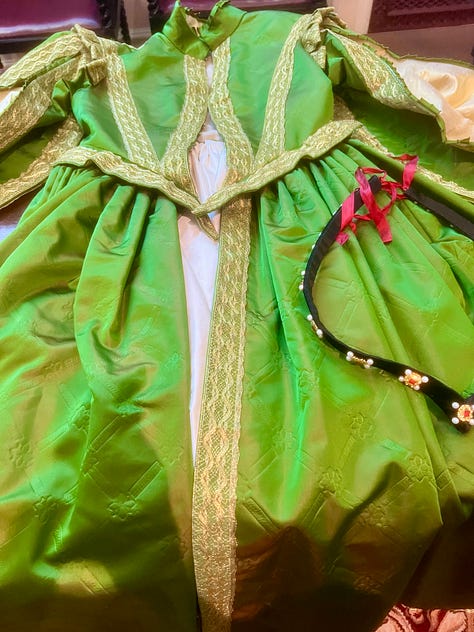
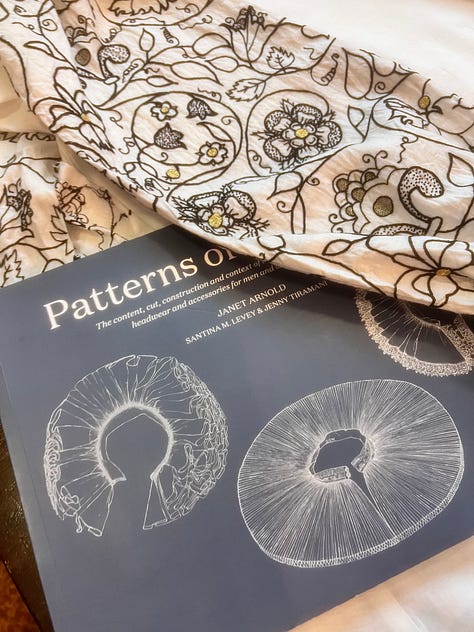
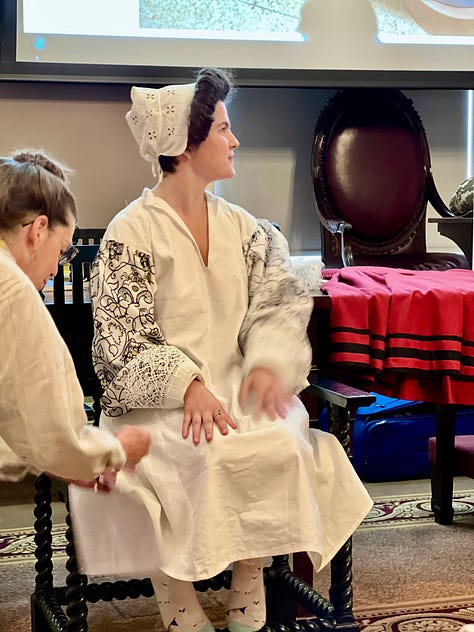
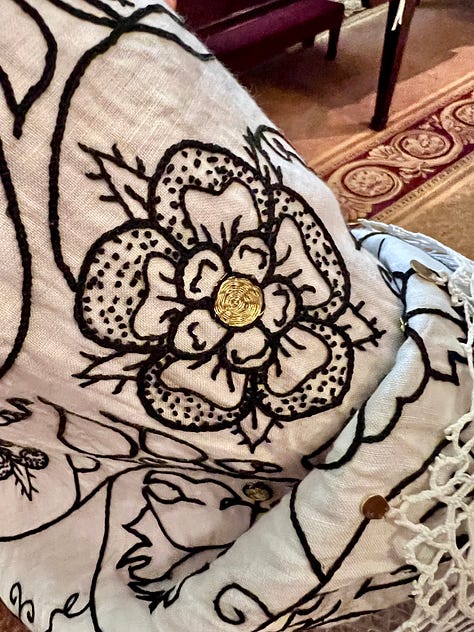
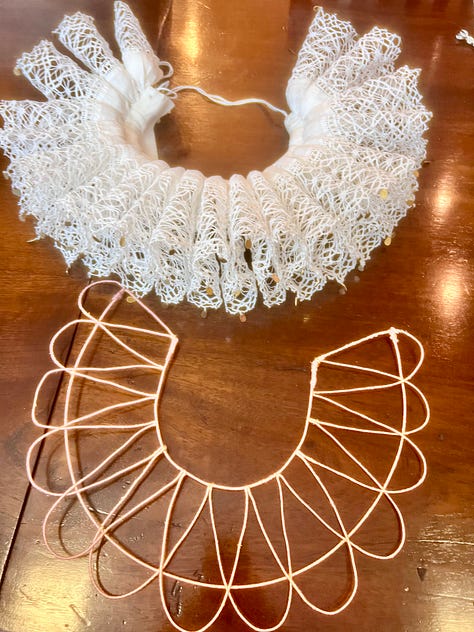
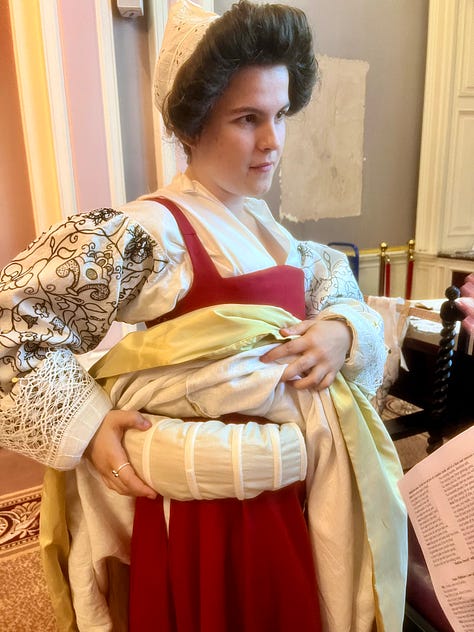
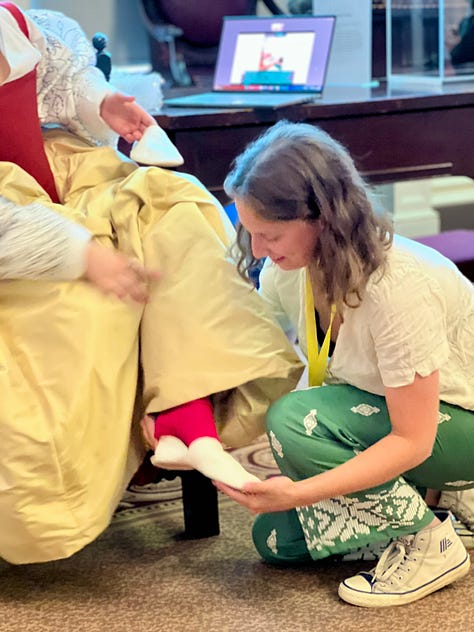
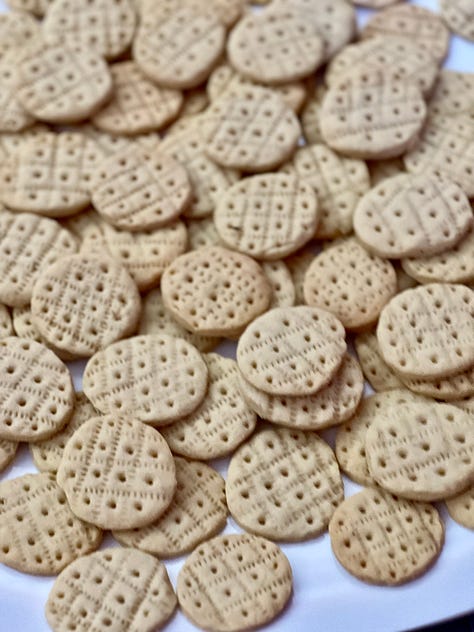
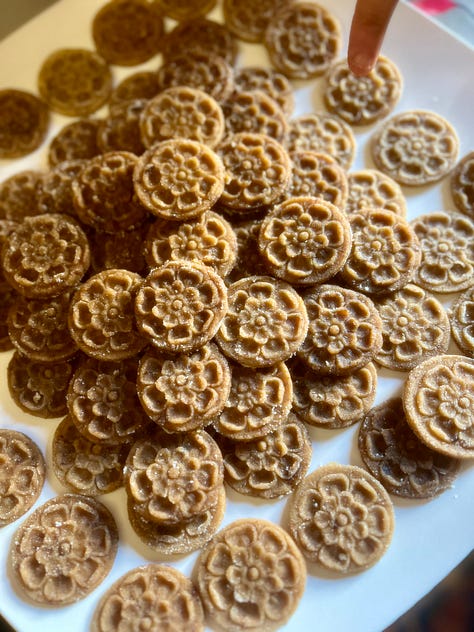
I sat in a room filled with mostly women; there were only three men and two of them were speakers. Many of them were silent tricoteuses, knitting their way through the lectures. A woman’s hands are never idle.
At Kentwell there was a strict hierarchy, everybody knew their rank. In Tudor times there were sumptuary laws, only royalty were allowed to wear purple or gold thread, only aristocrats could wear silk stockings or ostentatious ruffs, and if you wore something too posh for your station you risked a fine or even jail. Velvet, taffeta and satin was a tool to maintain hierarchy. There were watchers posted at the gates of London. Tailors were fined for making ‘outrageous hose’ or giant trousers. (Sumptuary laws have always existed, in Rome women were not allowed to wear togas although prostitutes could wear yellow togas).
We heard musicians play it on original instruments. There were lectures by seamstresses, shoe makers, lace makers. We saw a young woman being dressed in a white linen smock with blackwork (black embroidery), a kirtle (a kind of fitted tunic), a bustle, a ruff, cuffs, a bonnet called a ‘kercher’, hose, garters and finally a green silk gown with hanging split sleeves. We heard about historic techniques such as buckram, a stiffening method for bodices (and books), and busks, wooden lathes used to provide central support for corsetry, often carved and decorated and given as love tokens to suitors.
Recreating this costume took 50,000 hours. One embroiderer said it took 15 minutes to create 2.5 inches of embroidery and she is fast.
I’ve heard that green was the colour of prostitution (it’s the colour medieval painters used for Mary Magdalen’s gown whereas Mary the mother wore heavenly blue). But green was an unusual colour for Tudor women to wear. The medieval and early Tudor period were more colourful than the late 16th century where wearing black denoted wealth because it required more dye.
Many of the attendees, like the young female model Ellam had ‘graduated’ from Kentwell as children and turned their interest into a career as makers. I met one fascinating woman, a textile artist, who has been attending surgeries as an artist in residence at Imperial College, using her expertise in bobbin lace to help them come up with ways to improve vascular surgery.
During Tudor times, fabrics were ‘printed’ using heated brass tools pressed into damp silk, and sleeves were pinked, slashed, like tribal scars.
In Hilary Mantel’s books, Cromwell’s wife was a silkwoman, a prestigious and skilled category of merchant who traded in silk and was allowed independence from her husband. They would trade in ‘narrow ware’ such as garters, ribbons, girdles.
One of the speakers, who made the white leather pumps mentioned in Greensleeves, actually learned how to cure and tan the leather herself. She wore a pair of the thin leather slippers to walk in the Alps and remarked on how comfortable it was. People used to walk more lightly, toes first, before we had pavements and roads. (This has returned with the barefoot movement). A Shakespearian actor at the conference added that the oak boards at the Globe caused him a lot of pain in his legs, that they should have used Deal wood on a stage.
At the end Ivan Day served Shrewsbury Cakes (punched with combs to create designs), date leaches and confetti comforts.
He had eringoes (candied roots), white gingerbread, almond paste, quince knots and sugar gloves on display, something that would be used as part of a sugar banquet, eaten after a meal. Confectionary was considered to be medicinal, to settle the stomach. At Kentwell, us peasants were occasionally allowed to taste some sugary dainties made by the kitchen.
Making period food is very dependant on tools. Ivan started to collect, from the age of 13, a huge collection of moulds and historic kitchenalia. All of which he uses – ‘the forbidden thrill of using something precious and rare for ordinary life’.
I’ve always been interested in historical costume: in this piece I spent a week in Scotland making an 18th century Outlander corset.
If you want to find out more, follow Greensleeves Project on Instagram.
Vacuuming the Garden
The garden has been at its best recently, with plenty of sun and some rain. I made a blueberry galette from the fruit growing in my garden. Here is the recipe.
I was sent a wet and dry vacuum cleaner by Handy. It’s brilliant for the garden and made a quick job of cleaning up the shed and the terrace. It’s fine with the wet damp conditions outside but I’ve also used it on the stairs indoors. At £40 it’s a lot cheaper than most vacuum cleaners.
If you enjoy my substack, please consider taking out a paid subscription. It helps finance my work. Thanks in advance.




Fascinating indeed - I did know about black being an expensive fabric, intersting how green would be associated with prostitution! I too loooooved Diana Ross - saw her in cohcert in Bournemouth in 1976, she did not disappoint!
Fascinating! Didn’t know about the Greensleeves Project. And you look gorgeous in your frock and cape.